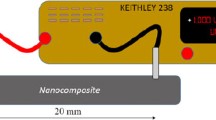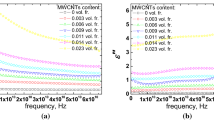Abstract
We report on electrical transport and noise processes of Epoxy/multi-wall carbon nanotube composites. The dc measurements suggest that the investigated system can be regarded as a random resistor network in which the resistors are located at the junctions between carbon nanotubes and the nodes are the conducting pathways connecting different junctions, namely the nanotubes themselves. The noise-spectral density measurements reveal the existence of a threshold voltage, above which a markedly nonlinear behavior is found and is tentatively related to the specific properties of the Epoxy-mediated contact barrier among the carbon nanotubes.
Access provided by Autonomous University of Puebla. Download conference paper PDF
Similar content being viewed by others
Keywords
- Carbon Nanotubes
- Electrical Transport
- Voltage Fluctuation
- Noise Property
- Electrical Conductivity Mechanism
These keywords were added by machine and not by the authors. This process is experimental and the keywords may be updated as the learning algorithm improves.
1 Introduction
Carbon nanotubes (CNTs) addition to polymer [1] or Epoxy material [2] strongly enhances the electrical and thermal conduction and also improves the mechanical properties of the organic material. This leads to a variety of new applications for the resulting nanocomposites, namely electromagnetic shielding, electrical heaters, physical and chemical sensoring, and aerospace applications. Regarding the electrical applications, investigations of the noise properties have been initially aimed at the evaluation of the intrinsic noise level. Recently, the so-called “fluctuation spectroscopy” has been proved to be a very informative method for revealing possible strategies to lower the intrinsic noise response, a mandatory requirement for the realization of high-performance devices based on these compounds. Here we study in detail the electrical transport and noise properties of Epoxy/multi-walled carbon nanotube composites in the temperature range between 10 and 300 K.
2 Experimental
The investigated Epoxy/CNT composites have been fabricated in the following way. A diglycidyl ether of bisphenol A-epoxy resin (DGEBA) has been mixed together with ultrasonically dispersed multi-wall carbon nanotubes (MWCNTs) and subsequently hardened with 4,4’diamine-dibenzyl-sulfone (DDS) hardener and cured in a two-step process first at 130°C for 1 h and subsequently at 180°C for 3 h. Because the percolation threshold of this kind of nanocomposites is rather low, CNT concentrations below 0.5wt% are sufficient to create a stable conducting nanotube network.
The electrical transport and noise properties of Epoxy/MWCNT composites have been analyzed using two and four-probe connections to the samples through evaporated gold contact pads. Possible effects of contact noise have been ruled out using appropriate techniques [3]. All the measurements have been carried out in a closed-cycle refrigerator. The temperature was stabilized using a GaAlAs thermometer and a resistance heater controlled in a closed feedback loop, giving a stability better than 0.1 K. The sample temperature has been measured by a Cernox resistance thermometer in contact with the sample holder. Further details of the experimental setup are reported in [3].
3 Results and Discussions
The temperature dependence of the resistance is shown in Fig. 6.1. In order to explain the conductivity mechanisms in this class of compounds, several theoretical models can be found in the scientific literature. According to our findings, the one that fits best our data is the fluctuation-induced tunneling (FIT) model, already used for multi-wall carbon nanotube nanocomposites [4].
According to FIT, in disordered materials generally characterized by large con-ducting regions (in this case the CNTs) separated by small insulating barriers (in this case the Epoxy interstitial matrix) the thermally activated voltage fluctuations across insulating gaps play an important role in the electrical conductivity mechanism [5]. A theoretical expression for the temperature dependence of the resistance can be derived as
where R 0 is a preexponential factor, and T 0 and T 1 are two characteristic temperatures of the investigated system [5].
The solid line in Fig. 6.1 is the best fit to the experimental data of Eq. 6.1, with the fitting parameter values reported in the inset. The effect of voltage fluctuations on the electric transport can also be understood analyzing the parallel conduction mechanism of thermal activation over the potential barrier. The temperature dependence of the resistance by thermal activation can be expressed as
where T v is another temperature parameter, and ? A is the dimensionless applied electric field [5].
The dashed line in Fig. 6.1 is the best fitting curve, using Eq. 6.2 with R 1 and T V values reported in the inset. As clearly explained in [5], it is possible to define a critical temperature T C = T 0 T V /T 1 above which thermal activation contribution is indistinguishable from the fluctuation-induced tunneling conductivity. T C , obtained by fitting our experimental data, is around 100 K and is shown in Fig. 6.1. The small value of T C , compared with others already reported for different types of MWCNT composites, allows us to consider a distribution of tunnel barriers characterized by small energy levels.
In overall, the dc measurements suggest that our compounds can be regarded as a random resistor network in which the resistors are located at the junctions between carbon nanotubes and the nodes are the conducting pathways connecting different junctions, namely the nanotubes themselves [6].
More sensitive investigations, such as noise measurements, have also been performed to better clarify the aspects related to the electrical transport processes of the analyzed composites. The noise-spectral density S V shows two main components. One with a 1/f dependence and the other with a constant spectrum, corresponding the expected value for Johnson noise 4K B TR. The bias voltage dependence of S V concerns only the 1/f part and can be generally expressed as
where the factor A is a measure of the noise level expressed in terms of the normalized Hooge parameter [7], ? is the voltage slope parameter, and S 0 is the voltage noise background ascribed to measurement electronics.
S V versus V curves, in the investigated temperature range [15–300] K, are reported in Fig. 6.2, which clearly shows the existence of two different behaviors with a well defined threshold voltage V T . Below V T a quadratic voltage dependence of the 1/f spectrum is observed, strongly supporting an origin of the electric noise due to “standard” resistance fluctuations [7]. Conversely, a markedly nonlinear dependence of S V is found above V T , revealing a significant decrease of the noise level.
This nonlinear behavior is also confirmed by measurements of the differential resistance R d as a function of the bias voltage V. A step-like decrease of R d is found in a small region around V T , for all the investigated temperatures. We speculate that the observed unusual experimental findings, not found in other types of CNT-composites, are strictly related to the specific properties of the Epoxy-mediated contact barrier among the CNTs, and in particular to the low amplitude of the energy barrier between adjacent CNTs, as evidenced by the R versus T analysis.
References
Paul DR, Robeson LM (2008) Polymer nanotechnology: nanocomposites. Polymer 49:3187
Guadagno L, Naddeo C, Vittoria V, Sorrentino A, Vertuccio L, Raimondo M, Tucci V, De Vivo B, Lamberti P, Iannuzzo G, Calvi E, Russo S (2010) Cure behavior and physical properties of epoxy resin—filled with multiwalled carbon nanotubes. J Nanoscience Nanotechnology 10:2686
Barone C, Galdi A, Pagano S, Quaranta O, Méchin L, Routoure JM, Perna P (2007) Experimental technique for reducing contact and background noise in voltage spectral density measurements. Rev Sci Instrum 78:093905
Simsek Y, Ozyuzer L, Seyhan AT, Tanoglu M, Schulte K (2007) Temperature dependence of electrical conductivity in double-wall and multi-wall carbon nanotube/polyester nanocomposites. J Mater Sci 42:9689
Sheng P (1980) Fluctuation-induced tunnelling conduction in disordered materials. Phys Rev B 21:2180
Wright DC, Bergman DJ, Kantor Y (1986) Resistance fluctuations in random resistor networks above and below the percolation threshold. Phys Rev B 33:396
Kogan S (1996) Electronic noise and fluctuations in solids. Cambridge University Press, Cambridge
Author information
Authors and Affiliations
Corresponding author
Editor information
Editors and Affiliations
Rights and permissions
Copyright information
© 2011 Springer Science+Business Media B.V.
About this paper
Cite this paper
Barone, C., Imparato, D., Pagano, S., Vertuccio, L., Sorrentino, A., Neitzert, H.C. (2011). Electrical Noise Characterization of Epoxy/MWCNT Composites. In: Neri, G., Donato, N., d'Amico, A., Di Natale, C. (eds) Sensors and Microsystems. Lecture Notes in Electrical Engineering, vol 91. Springer, Dordrecht. https://doi.org/10.1007/978-94-007-1324-6_6
Download citation
DOI: https://doi.org/10.1007/978-94-007-1324-6_6
Published:
Publisher Name: Springer, Dordrecht
Print ISBN: 978-94-007-1323-9
Online ISBN: 978-94-007-1324-6
eBook Packages: EngineeringEngineering (R0)






